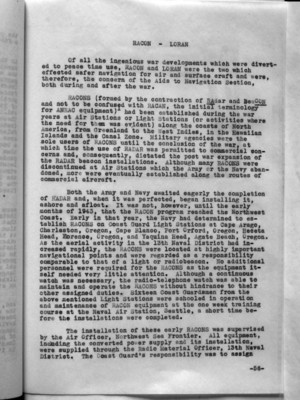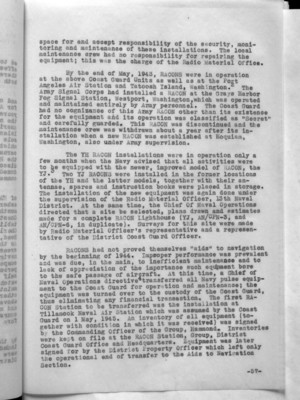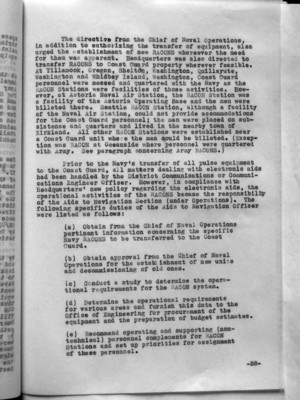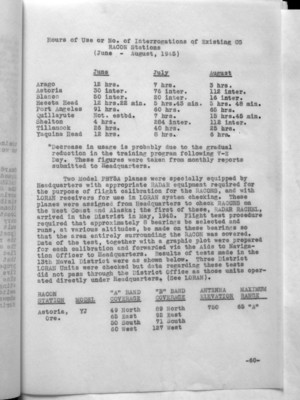Pages
76
Of all the ingenious war developments which were diverted to peace time use, RACON and LORAN were the two which effected safer navigation for air and surface craft and were, therefore, the concern of the Aids to Navigation Section, both during and after the war.
RACONS (formed by the contraction of RAdar and BeaCON and not to be confused with RACAN, the initial terminology for ANRAC equipment)¹ had been established during the war years at Air Stations or Light Stations (or activities where the need for them was evident) along the coasts of North America, from Greenland to the West Indies, in the Hawaiian Islands and the Canal Zone. Military agencies were the sole users of RACONS until the conclusion of the war, at which time the use of RADAR was permitted to commercial concerns and, consequently, dictated the post war expansion of the RADAR beacon installations. Although many RACONS were discontinued at Air Stations which the Army or the Navy abandoned, more were eventually established along the routes of commercial aircraft.
Both the Army and Navy awaited eagerly the completion of RADAR and, when it was perfected, began installing it, ashore and afloat. It was not, however, until the early months of 1943, that the RACON program reached the Northwest Coast. Early in that year, the Navy had determined to establish RACONS on Coast Guard Light Stations at Cape Arago, Charleston, Oregon, Cape Blanco, Port Orford, Oregon, heceta Head, Florence, Oregon, and Yaquina Head, Agate Beach, Oregon. As the aerial activity in the 13th Naval District had increased rapidly, the RACONS were located at highly important navigational points and were regarded as a responsibility comparable to that of a light or radiobeacon. No additional personnel were required for the RACONS as the equipment itself needed very little attention. Although a continuous watch was necessary, the radio-telephone watch was able to maintain and operated the RACONS without hindrance to their other assigned duties. Sixteen Coast Guardsmen from the above mentioned Light Stations were schooled in operation and maintenance of RACON equipment at the one week training course at the Naval Air Station, Seattle, a short time before the installations were completed.
The installation of these early RACONS was supervised by the Air Officer, Northwest Sea Frontier. All equipment, including the converted power supply and its installation, were supplied through the Radio Material Officer, 13th Naval District. The Coast Guard's responsibility was to assign
-56-
77
space for and accept responsibility of the security, monitoring and maintenance of these installations. The local maintenance crew had no responsibility for repairing the equipment; this was the charge of the Radio Material Office.
By the end of May, 1943, RACONS were in operation at the above Coast Guard Units as well as at the Port Angeles Air Station and Tatoosh Island, Washington. The Army Signal Corps had installed a RACON at the Grays Harbor Fog Signal Station, Westport, Washington, which was operated and maintained entirely by Army personnel. The Coast Guard had no cognizance of this Army RACON other than its existence for the equipment and its operation was classified as "Secret" and carefully guarded. This RACON was discontinued and the maintenance crew was withdrawn about a year after its installation when a new RACON was established at Hoquiam, Washington, also under Army supervision.
The YH RACON installations were in operation only a few months when the Navy advised that all activities were to be equipped with the newer, improved model of RACON, the YJ.³ Two YJ RACONS were installed in the former locations of the YH and the latter models, together with their antennae, spares and instruction books were placed in storage. The installation of the new equipment was again done under the supervision of the Radio Material Officer, 13th Naval District. At the same time, the Chief Of Naval Operations directed that a site be selected, plans drawn and estimates made for a complete RACON Lighthouse (YJ, AN/CPN-3, and AN/CPN-6, in duplicate). Surveys for this site were made by Radio Material Officer's representative and a representative of the District Coast Guard Officer.
RACONS had not proved themselves "aids" to navigation by the beginning of 1944. Improper performance was prevalent and was due, in the main, to inefficient maintenance and to lack of appreciation of the importance such equipment bore to the safe passage of aircraft. At this time, a Chief of Naval Operations directive^4 transferred all Navy pulse equipment to the Coast Guard for operation and maintenance; the equipment was turned over to the custody of the Coast Guard, thus eliminating any financial transaction. The first RACON Station to be transferred was the installation at Tillamook Naval Air Station which was assumed by the Coast Guard on 1 May, 1945. An inventory of all equipment (together with condition in which it was received) was signed by the Commanding Officer of the Group, Hammond. Inventories were kept on file at the RACON Station, Group, District Coast Guard Office and Headquarters. Equipment was later signed for by the District Property Officer which left only the operational end of transfer to the Aids to Navigation Section.
-57-
78
The directive from the Chief of Naval Operations, in addition to authorizing the transfer of equipment, also urged the establishment of new RACONS wherever the need for them was apparent. Headquarters was also directed to transfer RACONS to Coast Guard property wherever feasible. At Tillamook, Oregon, Shelton, Washington, Coast Guard personnel were messed and quartered with the Navy as the RACON Stations were facilities of those activities. However, at Astoria Naval Air Station, the RACON Station was a facility of the Astoria Operating Base and the men were billeted there. Seattle RACON Station, although a facility of the Naval Air Station, could not provide accommodations for the Coast Guard personnel; the men were placed on subsistence and quarters and lived in the nearby town of Kirkland. All other RACON Stations were established near a Coast Guard unit where the men could be billeted. (Exception was RACON at Oceanside where personnel were quartered with Army. See paragraph concerning Army RACONS.)
Prior to the Navy's transfer of all pulse equipment to the Coast Guard, all matters dealing with electronic aids had been handled by the District Communications or Communications Engineer Officer. However, in compliance with Headquarters' new policy regarding the electronic aids, the operational activities of the RACONS became the responsibility of the Aids to Navigation Section (under Operations). The following specific duties of the Aids to Navigation Officer were listed as follows:
(a) Obtain from the Chief of Naval Operations pertinent information concerning the specific Navy RACONS to be transferred to the Coast Guard.
(b) Obtain approval form the Chief of Naval Operations for the establishment of new units and decommissioning of old ones.
(c) Conduct a study to determine the operational requirements for the RACON system.
(d) Determine the operational requirements for various areas and furnish this data to the Office of Engineering for procurement of the equipment and the preparation of budget estimates.
(e) Recommend operating and supporting (non-technical) personnel complements for RACON Stations and set up priorities for assignment of these personnel.
-58-
79
(f) Arrange for the establishment of an appropriate system whereby all users of RADAR beacons are promptly notified of outages or defects.
(g) Prepare and disseminate operating instructions for RADAR beacons.
(h) Obtain and analyze operational reports from users and from field activities in the interest of bettering the service rendered to navigators using RADAR beacons.
(i) Advise the Communications Officer as to communication facilities required.
An Assistant Aids to Navigation Officer, especially trained in electronic aids, was assigned to the District to work particularly in this field.
When the transfer of RACONS from Navy to Coast Guard was pending, the Commanding Officer of the Blimp Squadron 33 at Tillamook, Oregon, fearing the coastal RACONS might be discontinued, set forth the importance of the RACON to his command as follows: "The airship, a slow moving aircraft designed to operate in conditions of reduced visibility at a low altitude, has, when such weather conditions exist, become dependent upon the coastal RACON Stations located clear of all interference of land masses as a primary method of making a landfall...... It is often difficult to identify portions of the coast in the P. P. I. (position plot indicator) scope due to the similarity of the received images of the bays and capes of this coastline. The airships position is immediately and positively verified upon timing in the RACON signals". This gave evidence that the earlier stigma of "inefficient operation and improper maintenance" of the RACONS was being eliminated. In five months of operation, under the Coast Guard supervision, nine failures occurred but only one RACON lost actual operating time (2 hours 15 minutes) as the standby units were switched on in all other instances. The following table shows the usage of the 13th Naval District existing RACONS during the June, July and August months of 1945:
-59-
80
Hours of Use or No. of Interrogations of Existing CO RACON Stations (June - August, 1915)
June July August Arago 12 hrs. 7 hrs. 3 hrs. Astoria 30 inter. 76 inter. 112 inter. Blanco 50 inter. 20 inter. 16 inter. Heceta Head 12 hrs.22 min. 5 hrs. 43 min 5 hrs. 48 min. Port Angeles 91 hrs. 60 hrs. 65 hrs. Quillayute Not. estbd. 7 hrs. 15 hrs. 45 min. Shelton 4 hrs. 284 inter. 112 inter. Tillamook 26 hrs. 40 hrs. 25 hrs. Yaquina Head 12 hrs. 8 hrs. 6 hrs.
*Decrease in usage is probably due to gradual reduction in the training program following V-E Day. These figures were taken from monthly reports submitted to Headquarters.
Two Model PBY5A planes were specially equipped by Headquarters with appropriate RADAR equipment required for the purpose of flight calibration for the RACONS, and with LORAN receivers for use in LORAN system checking. These planes were assigned from Headquarters to check RACONS on the West Coast and Alaska; the first of these, RADAR RACHEL, arrived in the District in May, 1945. Flight test procedure required that approimately 8 bearings be selected and runs, at various altitudes, be made on these bearings so that the area entirely surrounding the RACON was covered. Data of the test, together with a graphic plot were prepared for each calibration and forwarded via the Aids to Navigation Officer to Headquarters. Results of tests made in the 13th Naval District were as shown below. Three District LORAN Units were checked but data regarding these tests did not pass through the District Office as those units operated directly under Headquarters. (See LORAN).
RACON "A" Band "B" Band Antenna Maximum Station Model Coverage Coverage Elevation Range Astoria, YJ 49 North 89 North 750 65 "A" Ore. 65 East 92 East 50 South 71 South 60 West 127 West




